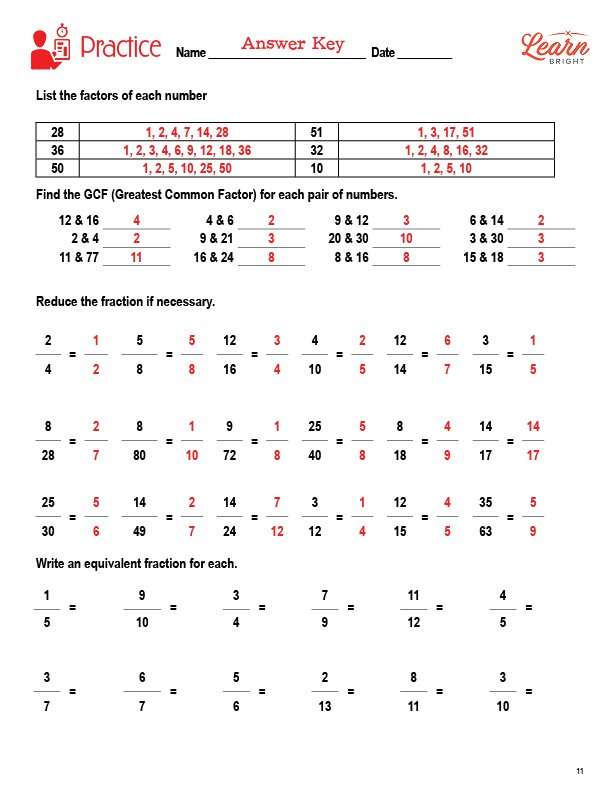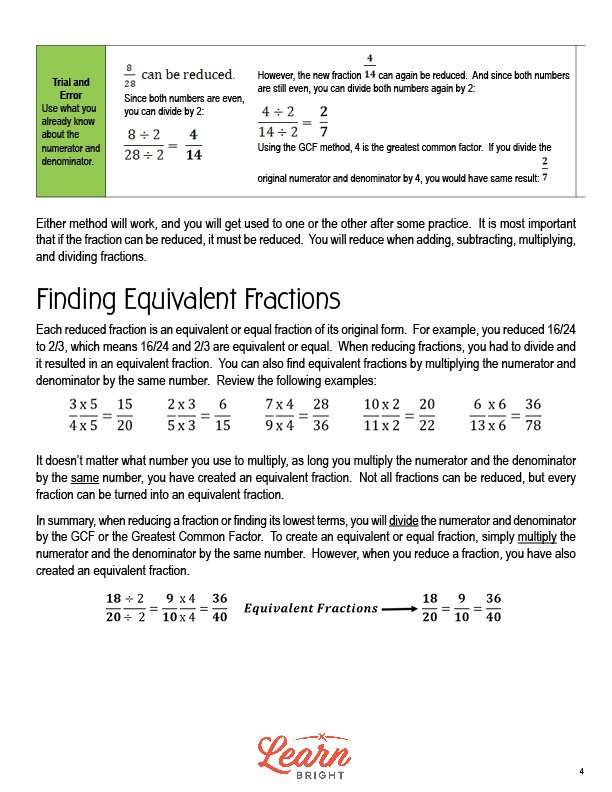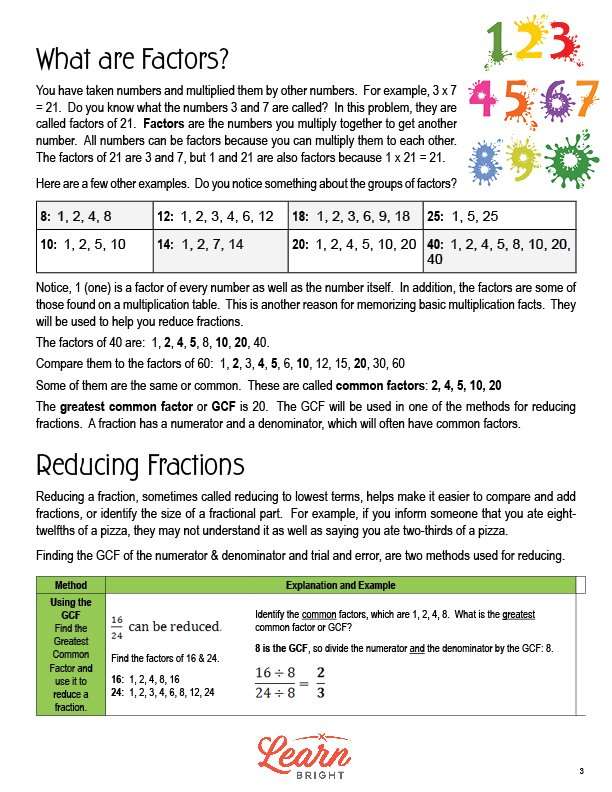Description
What our Fractions – Reducing lesson plan includes
Lesson Objectives and Overview: Fractions – Reducing teaches strategies for reducing fractions and writing equivalent fractions. The lesson introduces identifying the greatest common factors and prime factorization as primary methods for reducing fractions. At the end of the lesson, students will be able to identify greatest common factors as one method for reducing fractions. The students will be able to use prime factorization to reduce fractions. The students will be able to write equivalent fractions. This lesson is for students in 3rd grade, 4th grade, and 5th grade.
Classroom Procedure
Every lesson plan provides you with a classroom procedure page that outlines a step-by-step guide to follow. You do not have to follow the guide exactly. The guide helps you organize the lesson and details when to hand out worksheets. It also lists information in the blue box that you might find useful. You will find the lesson objectives, state standards, and number of class sessions the lesson should take to complete in this area. In addition, it describes the supplies you will need as well as what and how you need to prepare beforehand.
Options for Lesson
Included with this lesson is an “Options for Lesson” section that lists a number of suggestions for activities to add to the lesson or substitutions for the ones already in the lesson. One optional addition to this lesson is to have your students use construction paper, scissors, and other supplies to create representations of equivalent fractions. Instead of using the activity pages, students could use construction paper to draw images. You could also have your students use hands-on manipulatives to show equivalent fractions.
Teacher Notes
The teacher notes page includes a paragraph with additional guidelines and things to think about as you begin to plan your lesson. This page also includes lines that you can use to add your own notes as you’re preparing for this lesson.
FRACTIONS – REDUCING LESSON PLAN CONTENT PAGES
What are Factors?
The Fractions – Reducing lesson plan includes two content pages. Students have already multiplied numbers by other numbers. For example, 3 x 7 = 21. In this problem, we call 3 and 7 factors of 21. Factors are the numbers that you multiply together to get another numbers. All numbers can be factors, because all numbers can be multiplied. The factors of 21 are 3 and 7, but also include 1 and 21, because 21 x 1 = 21.
The factors of 8 are 1, 2, 4, and 8. The factors of 12 are 1, 2, 3, 4, 6, and 12. And the factors of 40 are 1, 2, 4, 5, 8, 10, 20, and 40. Notice that 1 and the number itself are always included in the list of factors.
The factors of 40 are 1, 2, 4, 5, 8, 10, 20, and 40, and the factors of 60 are 1, 2, 3, 4, 5, 6, 10, 12, 15, 20, 30, and 60. They have some factors in common! We call these common factors. The common factors of 40 and 60 are 2, 4, 5, 10, and 20. The greatest common factor (GCF) is 20, because it’s the largest in the list of common factors. We use the GCF to help reduce fractions. Fractions have a numerator and denominator, and these numbers often have common factors.
Reducing Fractions
Reducing fractions, sometimes also called reducing to lowest terms, makes it easier for us to compare and add fractions and find the size of a fractional part. For example, someone will understand 2/3s easier than 8/12s.
Two methods that we use for reducing are finding the GCF and using trial and error. When using the GCF, we identify the common factors. For the example fraction 16/24, the common factors are 1, 2, 4, and 8. The GCF is 8. We then divide both the numerator and the denominator by the GCF: 16 / 8 = 2 and 24 / 8 = 3, so the reduced fraction is 2/3.
We can also use trial and error, using the information we already know about the numerator and denominator. For the example problem 8/28, we know that we can divide both numbers by 2, since they are both even numbers. However, the new fraction, 4/14, can be reduced further. Again, we know we can divide both by 2, so we do that again to get a new reduced fraction of 2/7.
You can use either method, and will likely use a combination of both as you practice. It is most important to remember that you always have to reduce your fractions!
Finding Equivalent Fractions
All reduced fractions are equal to their original forms. For example, if you reduced 16/24 to 2/3, 16/24 and 2/3 are equivalent or equal. Reducing is one way to find an equivalent fraction.
Another method for finding equivalent fractions is by multiplying the numerator and denominator by the same number. For example, 3 x 5 = 15 and 4 x 5 = 20, so 3/4 and 15/20 are equivalent fractions.
You can multiply by any number and you will always get an equivalent fraction as long as you multiply both the numerator and the denominator. Not all fractions can be reduced, but you can find an equivalent fraction for all fractions.
FRACTIONS – REDUCING LESSON PLAN WORKSHEETS
The Fractions – Reducing lesson plan includes three worksheets: an activity worksheet, a practice worksheet, and a homework assignment. You can refer to the guide on the classroom procedure page to determine when to hand out each worksheet.
EQUIVALENT FRACTIONS ACTIVITY WORKSHEET
For the activity worksheet, students will create an equivalent fraction for each listed on the worksheet. They will then create an image that shows they are equivalent.
FACTORS AND FRACTIONS PRACTICE WORKSHEET
The practice worksheet asks students to first list the factors of each number listed. They will then find the GCF for pairs of numbers. Next, they will reduce different fractions. Finally, they will write an equivalent fraction for each fraction listed.
FRACTIONS – REDUCING HOMEWORK ASSIGNMENT
For the homework assignment, students will answer eight questions about the lesson material, including a few true or false questions. They will then fill in the blanks in seven statements about reducing fractions.
Worksheet Answer Keys
This lesson plan includes answer keys for the activity worksheet, the practice worksheet, and the homework assignment. If you choose to administer the lesson pages to your students via PDF, you will need to save a new file that omits these pages. Otherwise, you can simply print out the applicable pages and keep these as reference for yourself when grading assignments.









